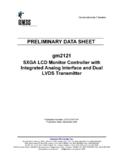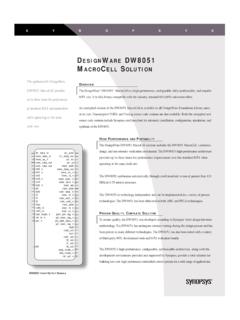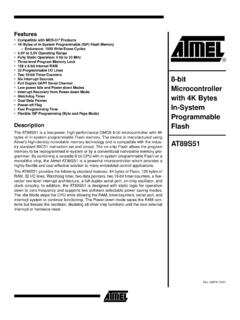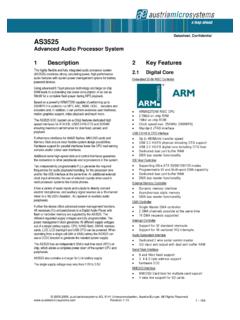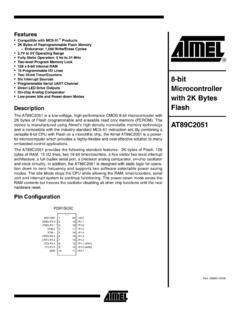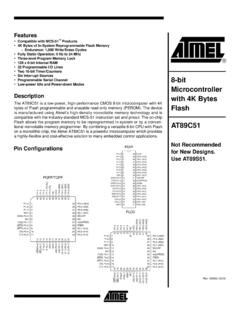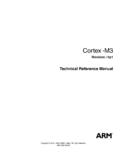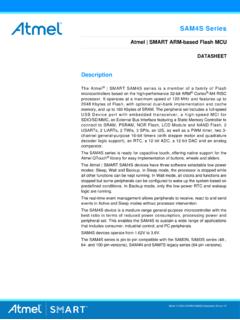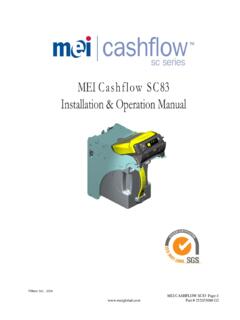Transcription of Using Cortex-M3/M4/M7 Fault Exceptions
1 AN209 Using Cortex-M3/M4/M7 Fault Exceptions Copyright 2017 ARM Ltd. All rights reserved Using Cortex-M3/M4/M7 Fault Exceptions MDK Tutorial AN209, Summer 2017, V Abstract ARM Cortex -M processors implement an efficient exception model that traps illegal memory accesses and several incorrect program conditions. This application note describes the Cortex-M Fault Exceptions from the programmers view and explains their usage during the software development cycle. It also contains an example of a HardFault handler that reports information about the underlying Fault . Contents Using Cortex-M3/M4/M7 Fault Exceptions ..1 Abstract ..1 Introduction ..2 Prerequisites ..2 Fault exception handlers ..2 Fault exception numbers and priority ..2 Priority escalation ..3 Synchronous and asynchronous BusFaults ..3 Fault types ..3 Fault exception registers.
2 4 Control registers for Fault Exceptions ..4 Configuration and Control Register CCR ..5 System Handler Priority Register SHP ..5 System Handler Control and State Register Status and address registers for Fault Exceptions ..7 HardFault Status Register HSFR Register ..7 Configurable Fault Status Register CFSR Register ..8 MemManage Fault Status and Address Registers (MMFSR; MMFAR) ..8 BusFault Status and Address Register (BFSR; BFAR) ..9 UsageFault Status Register (UFSR) .. 11 Auxiliary Bus Fault Status Register ABFSR Register (Cortex-M7 only) .. 12 Implementing Fault handlers .. 13 HardFault handler example .. 13 Fault handling considerations for ARM Cortex-M7 .. 14 Debugging faults with Vision .. 15 Determining which exception has occurred .. 15 Accessing the Fault Reports dialog from the Peripherals menu .. 16 Determining where the exception has occurred.
3 17 Further documentation .. 18 Revision history .. 18 AN209 Using Cortex-M3/M4/M7 Fault Exceptions Copyright 2017 ARM Ltd. All rights reserved Introduction To detect problems as early as possible, all Cortex-M processors have a Fault exception mechanism included. If a Fault is detected, the corresponding Fault exception is triggered and one of the Fault exception handlers is executed. This application note describes the usage of Fault Exceptions . It lists the peripheral registers in the System Control Block (SCB) that control Fault Exceptions or provide information of their cause. Software examples show the usage of Fault Exceptions during program debugging or for recovering errors in the application software. Prerequisites This application note is accompanied by an example project with an exemplary HardFault handler. The example requires CMSIS version or later to be present in your development environment.
4 Download the example from Fault exception handlers Fault Exceptions trap illegal memory accesses and illegal program behavior. The following conditions are detected by Fault exception handlers: HardFault: is the default exception and can be triggered because of an error during exception processing, or because an exception cannot be managed by any other exception mechanism. MemManage: detects memory access violations to regions that are defined in the Memory Management Unit (MPU); for example, code execution from a memory region with read/write access only. BusFault: detects memory access errors on instruction fetch, data read/write, interrupt vector fetch, and register stacking (save/restore) on interrupt (entry/exit). UsageFault: detects execution of undefined instructions, unaligned memory access for load/store multiple. When enabled, divide-by-zero and other unaligned memory accesses are detected.
5 Fault exception numbers and priority Each exception has an associated exception number and an associated priority number. To simplify the software layer, the CMSIS only uses IRQ numbers and therefore uses negative values for Exceptions other than interrupts. The table lists Fault Exceptions ordered by their priority. Exception Exception Number Priority IRQ Number Activation HardFault 3 -1 -13 - MemManage Fault 4 Configurable -12 Synchronous BusFault 5 Configurable -11 Synchronous when precise, asynchronous when imprecise. UsageFault 6 Configurable -10 Synchronous The HardFault exception is always enabled and has a fixed priority (higher than other interrupts and Exceptions , but lower than Non-Maskable Interrupt NMI). The HardFault exception is therefore executed in cases where a Fault exception is disabled or when a Fault occurs during the execution of a Fault exception handler.
6 All other Fault Exceptions (MemManage Fault , BusFault, and UsageFault) have a programmable priority. After reset, these Exceptions are disabled and may be enabled in the system or application software Using the registers in the System Control Block (SCB). AN209 Using Cortex-M3/M4/M7 Fault Exceptions Copyright 2017 ARM Ltd. All rights reserved Priority escalation Usually, the exception priority, together with the values of the exception mask registers, determines whether the processor enters the Fault handler, and whether a Fault handler can preempt another Fault handler. In some situations, a Fault with configurable priority is treated as a HardFault. This is called priority escalation, and the Fault is described as escalated to HardFault. Escalation to HardFault occurs when: A Fault handler causes the same kind of Fault as the one it is servicing.
7 This escalation to HardFault occurs because a handler cannot preempt itself (it must have the same priority as the current priority level). A Fault handler causes a Fault with the same or lower priority as the Fault it is servicing. This is because the handler for the new Fault cannot preempt the currently executing Fault handler. An exception handler causes a Fault for which the priority is the same as or lower than the currently executing exception. A Fault occurs and the handler for that Fault is not enabled. If a BusFault occurs during a stack push when entering a BusFault handler, the BusFault does not escalate to a HardFault. This means that if a corrupted stack causes a Fault , the Fault handler executes even though the stack push for the handler failed. The Fault handler operates but the stack contents are corrupted. Note: Only Reset and NMI can preempt the fixed priority HardFault.
8 A HardFault can preempt any exception other than Reset, NMI, or another HardFault. Synchronous and asynchronous BusFaults BusFaults are subdivided into two classes: synchronous and asynchronous bus faults. The Fault handler can use the BFSR to determine whether faults are asynchronous (IMPRECISERR) or synchronous (PRECISERR). Synchronous bus faults are also described as a precise bus faults. They refer to an exception that takes place immediately after the bus transfer is carried out. A synchronous BusFault can escalate into lockup if it occurs inside an NMI or HardFault handler. Cache maintenance operations can also trigger a BusFault. Debug accesses can also trigger a BusFault. Debugger load or store accesses are synchronous, and are visible to the debugger interface only. Asynchronous bus faults are described as imprecise bus faults and can happen when there is write buffering in the processor design.
9 As a result, the processor pipeline proceeds to the subsequent instruction execution before the bus error response is observed. When an asynchronous bus Fault is triggered, the BusFault exception is pended. If another higher priority interrupt event arrived at the same time, the higher priority interrupt handler is executed first, and then the BusFault exception takes place. If the BusFault handler is not enabled, the HardFault exception is pended instead. A HardFault caused by an asynchronous BusFault never escalates into lockup. Asynchronous faults are often unrecoverable, as you do not know which code caused the error. Fault types The following table shows the Fault type, Fault handler, the Fault status register, and the register bit name that indicates which Fault has occurred. The bit names correlate with the fields shown in the Vision debug Fault Reports dialog.
10 Details are further described in register description section. Fault type Handler Status Register Bit Name Bus error on a vector read error HardFault HFSR VECTTBL Fault that is escalated to a hard Fault FORCED Fault on breakpoint escalation DEBUGEVT Fault on instruction access MemManage MMFSR IACCVIOL AN209 Using Cortex-M3/M4/M7 Fault Exceptions Copyright 2017 ARM Ltd. All rights reserved Fault on direct data access DACCVIOL Context stacking, because of an MPU access violation MSTKERR Context unstacking, because of an MPU access violation MUNSTKERR During lazy floating-point state preservation MLSPERR During exception stacking BusFault BFSR STKERR During exception unstacking UNSTKERR During instruction prefetching, precise IBUSERR During lazy floating-point state preservation LSPERR Precise data access error, precise PRECISERR Imprecise data access error.



